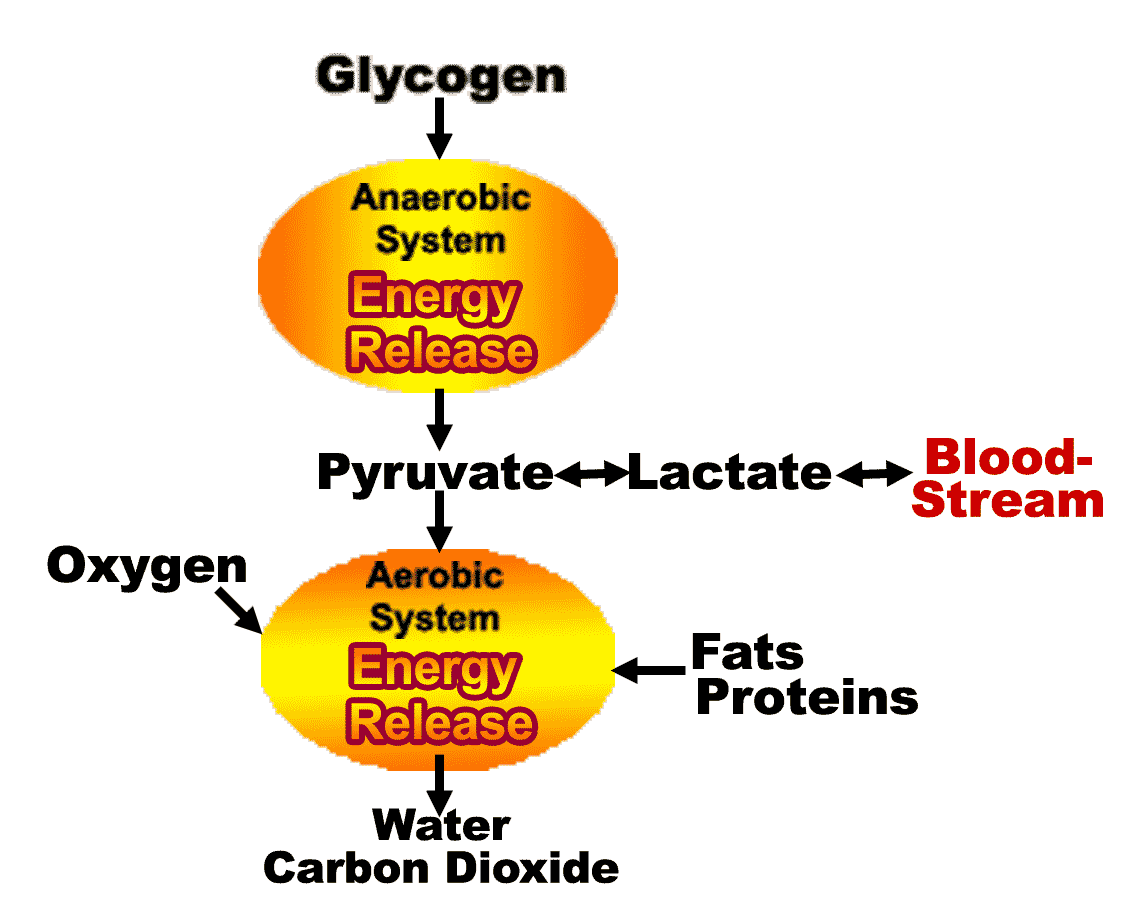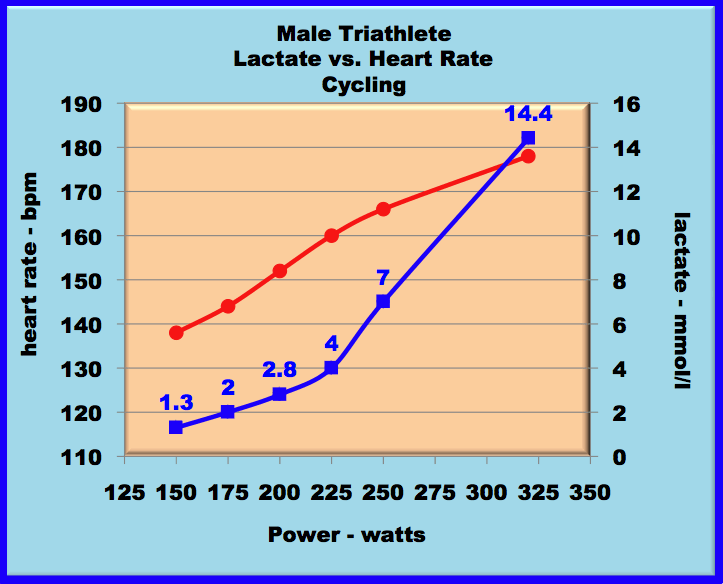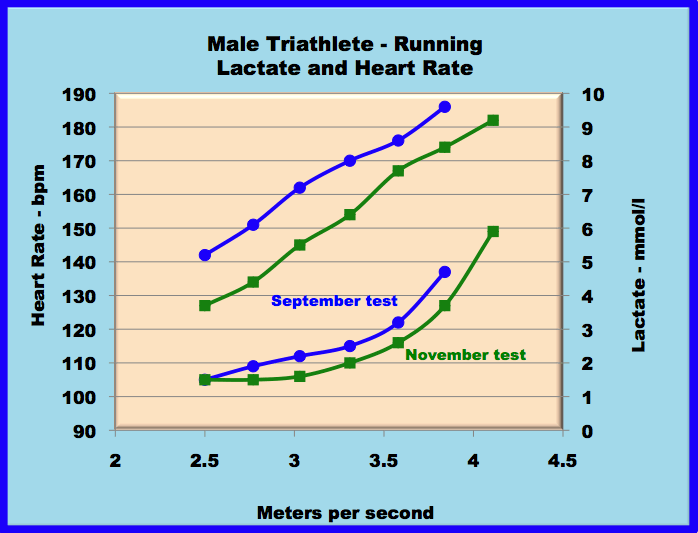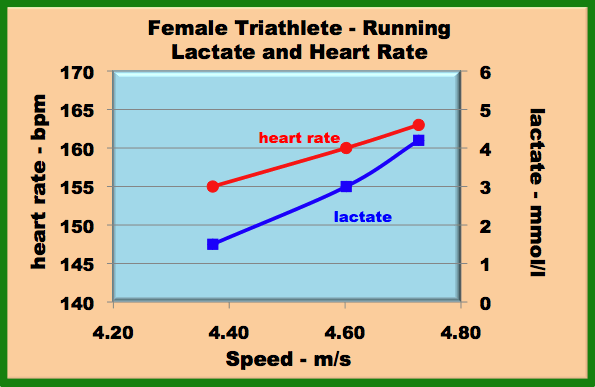Luc Van Lierde on lactate testing
Endurance Events and Lactate Testing
With Emphasis on the Triathlon
3 of 19
Why Lactate Is Unique
Lactate is different from all other measures
Many coaches have said that lactate is interesting, but surely there are other factors that will tell the coach as much or more. Actually, there are not. Lactate is different. Lactate is the unique metabolic variable that reveals the capability of the muscles for an athletic performance. We emphasize "unique" in the preceding sentence because no other metabolic parameter provides the same information. We have already shown that the athlete’s pace when lactate starts to accumulate correlates with performance in endurance events
That alone is more than just useful. It points to how successful one’s training has been. In addition, lactate has an extremely important role in energy metabolism. Lactate is an output of the anaerobic process and a fuel for the aerobic process. Blood lactate levels taken during a well-designed exercise protocol indicate the strength of each system. No other single parameter provides this information. And the strength of both systems determine how fast and how long one can contract the muscles during a race.

the basic aerobic and anaerobic energy systems used in the triathlon
The above diagram shows that pyruvate is the output of the anaerobic system and the input of the aerobic system. Pyruvate immediately turns into lactate in the muscles and just before it is used in aerobic energy, lactate turns back into pyruvate. So it is lactate in the muscle cells and bloodstream, not pyruvate. See the Basic Energy Section for more details. Some of this is pretty technical and is mainly provided to demonstrate why lactate is important.
Do you know what your lactate curve looks like?
The following six charts show the relationship between lactate, heart rates and VO2 against running speed or power.

In this chart three parameters are plotted: running speed, VO2 and lactate. As running speed climbs so does the consumption of VO2. Lactate remains steady at first and then begins an exponential climb. The VO2 is a direct measure of the aerobic system, but says nothing about the anaerobic system. That is where lactate comes in. Lactate is related to both energy systems, first as the output of the anaerobic system and then as the primary fuel for the aerobic system during intense exercise. In other words, lactate is a window into both energy systems. Both systems need to be calibrated properly by appropriate training.
This particular test is not designed to assess the strength of anaerobic system per se but one can see the anaerobic system at work through the lactate curve. When the pace or effort level reaches a certain point the lactate rises quickly. This is a direct indication that the anaerobic system is being used more and more. This runner, who is a college soccer player, does not have a very high VO2 max and yet the anaerobic system is not exerting itself at moderate running paces.
The step test is mainly used to measure aerobic capacity, but it also provides an estimate of the lactate threshold or maximal lactate steady state. So at every point lactate is telling the coach something about the conditioning level of the athlete for both energy systems.
- it shows where the threshold is – how fast or powerful the athlete can maintain effort without
lactate building up
- it gives an indication of the strength of the anaerobic system, especially at the high
levels
- it is a good estimate of the strength of the aerobic system. That is why it is so valuable.
Neither heart-rate or power provides all this information. This is why neither of these measures is a replacement for lactate. It would be best if it were possible to measure the lactate in the muscle but this is a highly complex procedure. Blood lactate is an alternative that has been shown to correlate well with muscle lactate. And despite what many say, a lactate meter is a fraction of the cost of a power meter, and very thorough threshold tests for all three disciplines can be done for under $50. This is not a major expense for most triathletes.

The second chart plots lactate and heart rate against power. Here the heart rate follows a typical VO2 pattern, but it is not a direct reflection of either of the two energy systems. Heart rate represents total stress on the body and can reflect such things as heat, hydration deficiencies, lack of sleep, overall health etc. as well as the obvious demands by the body for oxygen. It has some very practical uses and one of them is to relate actual stress found during a test situation with speed or effort on a bike or during a run on the road or in the woods. Heart rates are not necessarily a good window into the two energy systems as they have no way to estimate the effort being provided by the anaerobic system. Many cyclists have now abandoned heart rates as a guide during a workout or a competition because they prefer to use power which is much easier to interpret and more relevant. But power, while a valuable measure, does not provide the same insight into the energy systems that lactate does.

This chart illustrates a very interesting trend. It compares one lactate and heart rate test (blue lines) with those at a later date (red lines). The lactate at every power level is lower. What would cause this? The amount of energy the cyclist needs at each power level is the same. Such a pattern is best explained because there is a different mixture of aerobic and anaerobic energy. This is most likely due to either an increase in aerobic capacity, or a decrease in anaerobic capacity, or both. The curve has moved to the right, which indicates a much higher threshold. The V4 has moved from approximately 330 watts to around 360 watts. This is a big jump and going over the training and past history of the athlete will tell the coach just what caused the change and whether it is mainly due to increased aerobic capacity or decreased anaerobic capacity.
The next chart represents what looks like a test of a serious, but not elite, triathlete (male 30 years old who has been doing triathlons for just 2 years). But the details are interesting.
- A piece of background not on the chart is that this athlete has a high VO2 max, just
short of some of the riders on the Tour de France. This is an indication of a strong and highly trained
aerobic system
- This athlete’s threshold (V4) is 225 watts, nowhere near the Tour de France level (these are 350 watts
or much greater).
- Why would this be? There are 2 clues:
- There is no baseline on this graph. The testing starts at 150 watts and the lactate heads
straight up. A popular method for determining the lactate threshold is to say it is 1 mmol/l above baseline
and would not be possible with this test.
- The final lactate is 14.4, very high for an endurance athlete.

Because There isn't any baseline and the final lactate is very high. This suggests that this athlete has a very high anaerobic capacity and is pushing out a lot of lactate at every effort level, including what should be relatively easy power levels of 175 w and 200 w. Even with his high aerobic capacity, his muscles cannot use all the lactate being produced at these relatively low power levels and it is building up from the beginning. This athlete most likely needs to lower his anaerobic capacity so that he can more fully utilize his high VO2 max. His high anaerobic capacity is getting in his way. Right now he is only able to use about 65%-70% during a race when he should be able to utilize up to 85%. This is normally a trainable situation but it may take awhile.
The lactate test indicated why he is under-performing his potential. If he had just done a normal LT power test or LT HR test, he would not have known what was happening inside his muscles.
The next chart uses a typical lactate test but also a measure of the anaerobic capacity of the athlete to provide the coach with information on what is actually happening as a result of training. This male triathlete who we will classify as a good recreational triathlete wants to get better and has started lactate testing as a way to better plan his training. The following chart shows the results of two lactate tests taken 8 weeks apart.

There is some important information that is not on these charts. The athlete completed a test of his anaerobic capacity. It was an all out test that lasted just less than a minute. After both aerobic tests the athlete rested for about 20 minutes and performed the all out test. The results were almost identical. His max lactate was 13 mmol/l and 13.1 mmol/l respectively for each test. This indicated two things
- first, that there was little change in his anaerobic capacity after 8 weeks of training and the
changes in the lactate curve almost certainly indicate an increase in aerobic capacity. Just what the coach
had hoped for.
- second, the anaerobic capacity was too high and should be lowered for even better results. So now
training could include attempts to lower the anerobic capacity and the athletes should see even more
improvement.
The coach and the athlete were in control of the training process, doing things he would not have been able to do with heart rates alone.
The next chart represents a situation often found in endurance athletes, a low anaerobic capacity. It is one of the main reasons why someone is an endurance athlete, they do not have the anaerobic system throwing lactate and other metabolites into their muscles and causing problems with contraction. But they are also not very fast at short races.

This athlete completed three 2000 m runs on a track at roughly 15 seconds faster for each 2000 m. Based on the lactate results of this test, this athlete should be an elite female triathlete as least in running. But she was not. She completed an anaerobic test, a 600 m all out run and only generated 3.9 mmol/l of lactate. This is extremely low and it means that her V4 was highly influenced by this low anaerobic capacity and over estimated what she was capable of doing aerobically. If she had completed a standard distance test, running all out for 30 minutes, the result would have distorted her threshold substantially and her aerobic abilities. Her training would now include more anaerobic capacity training than would be normal for a triathlete. But most of her volume would actually be lower paces than someone else with the same V4.
It is also very common to see someone at the opposite end of the anaerobic capacity spectrum. There was a recreational triathlete who just liked to compete on weekends in Olympic length triathlons. He completed a series of 2000 m runs on a track and his V4 was about 6:40 per mile pace which was not bad for someone who only trained about 8 hours a week. He then completed a 600 m all out test and generated almost 18 mmol/l of lactate. This is very high for a triathlete. So his V4 was underestimating his aerobic capabilities. He could if he wanted to become a serious triathlete and compete and do well in major events. He would have to concentrate on lowering his anaerobic threshold and that would take time and a lot of training. But he wasn't interested in that. He was just interested in doing half decent and enjoying the friends he met during the meets.
The lactate curves and the anaerobic capacity information let's the coach understand each athlete's body and how it responds to training and find each athlete's best training practices. It is not a black box that that is being trained but two energy systems and lactate is a window into both of them. Yes, lactate is unique!
Do you know what your lactate curve looks like?
Learning to Balance
The ability of the muscles to contract quickly for a peak performance during an athletic event requires that the energy systems providing energy be fine-tuned. They need to be balanced properly so the athlete can generate the highest amount of energy per unit of time during a race of a specific length. We have just pointed out in the previous module that this balance is what determines which runner will win a particular race. Proper training is what accomplishes this fine-tuning or optimal balance. Lactate testing lets the coach know if the balance has been obtained, or how each energy system must be trained further in order to optimize the balance.
The anaerobic system is difficult to measure correctly. In the diagram above it means trying to assess how much lactate is being produced by glycolysis. However, just because the anaerobic contribution is hard to measure does not make it any less important. And it is very important. The main reason why nearly all sports scientists ignore the anaerobic system is that they say that it does not provide much of the energy for long events. But this attitude misses one of the key aspects of the anaerobic system, that the strength of the anaerobic system has a major impact on how much aerobic energy can be utilized, and that is critical to how well the athlete performs. It is not the amount of the anaerobic energy produced that is important but the controlling nature of the anaerobic system on total energy production that is important. Specifically, if the anaerobic system is inappropriately strong, it gets in the way, and will depress performance in long competitions. So we repeat; balance the energy systems to maximize the energy output. Train aerobic capacity to a maximum and then adjust the anaerobic capacity to allow the utilization to as high a level as possible. Not possible if you assume everyone with the same threshold numbers are the same.
Coaching is a profession requiring both art and science. The building blocks for an optimal performance are many and must be constructed in a proper sequence. They must recognize that each individual is different. Some of these building blocks are correct technique, positive mental attitude and a proper diet. However, the cornerstone for this building is precise physiological training. That is the main reason an athlete spends so much time in the water, on the bike, on the track or the road, in the weight room or wherever training is best conducted. Ask yourself: do you know if all those miles/hours of training are paying out?
But what is appropriate physiological training? It is not volume alone, or those who put in the most hours/miles would always win. It is not intensity alone, or those who pushed themselves the hardest would always win. It is not this year’s fashionable workout, or everyone would use the magic workout, and no one would be better than any one else! It turns out that each individual has a distinct way of adapting, and any smart training plan must recognize individual differences. This is a fact of life. Each has to find his or her own best way to the proper balance of the energy systems and peak conditioning on the day that counts, race day.
With proper protocols a portable lactate analyzer enables the coach to measure both the aerobic and anaerobic conditioning of each athlete. Information about both is necessary for the coach to optimize the training of each athlete, whether he is a 50-meter freestyle swimmer (about 22 seconds plus per race) or an Ironman triathlete (over 8 hours per race for the world's best). With information on each energy system the coach can plan, control and monitor the training of athletes with a precision not available before. Lactate testing provides the important information that enables the coach to individualize the intensity of each athlete's workout and control their training so they reach performance objectives. No over-training and no surprises come race day.

If you do not
keep your eye on both,
then you will get a sub optimal performance.
One Last Thing – What about Thresholds?
The triathlon community seems to put a lot of emphasis on the lactate threshold or what is called functional threshold power. There are a lot of different definitions of thresholds, all with slightly different relationships to aerobic and anaerobic energy supply. The only metabolic threshold that can be considered a reliable reference for the long-term performance capacity of an athlete is the maximal lactate steady state (MLSS). However, even this is of limited use by itself. Two athletes may have the same MLSS, but it could be due to very different metabolic contributions. So two athletes with the same MLSS may have to train very differently. Also an athlete really should not train at the MLSS very often. It is one of the most stressful training exercises there is and a formula for over-training if used more than just occasionally.
Despite this caution on the use of thresholds in training and the interpretation of lactate results, we are preparing a very comprehensive discussion of thresholds which takes into consideration a wide range of factors affecting lactate levels. Hopefully, it will be ready within the next year.
Continue on to module 4 which discusses basic energy metabolism
